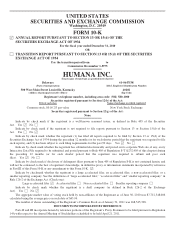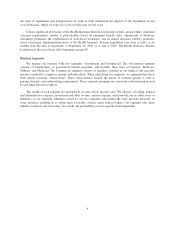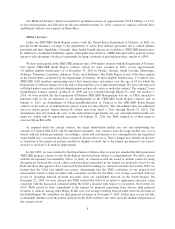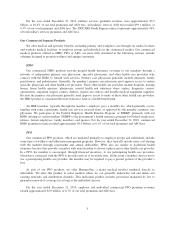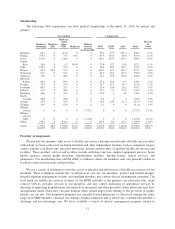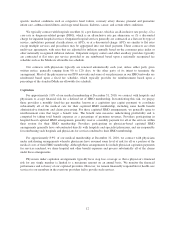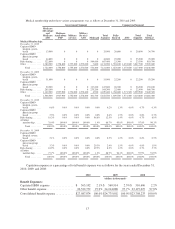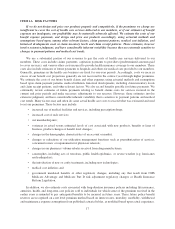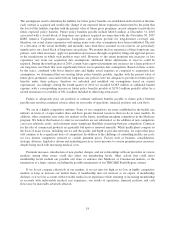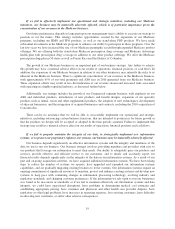Humana 2010 Annual Report Download - page 19
Download and view the complete annual report
Please find page 19 of the 2010 Humana annual report below. You can navigate through the pages in the report by either clicking on the pages listed below, or by using the keyword search tool below to find specific information within the annual report.For the year ended December 31, 2010, military services premium revenues were approximately $3.5
billion, or 10.4% of our total premiums and ASO fees, and military services ASO fees totaled $99.1 million, or
0.3% of our total premiums and ASO fees. The TRICARE South Region contract represents approximately 96%
of total military services premiums and ASO fees.
Our Commercial Segment Products
We offer medical and specialty benefits, including primary and workplace care through our medical centers
and worksite medical facilities, to employer groups and individuals in the commercial market. Our commercial
medical products offered as HMO, PPO or ASO, are more fully described in the following sections, include
offerings designed to promote wellness and engage consumers.
HMO
Our commercial HMO products provide prepaid health insurance coverage to our members through a
network of independent primary care physicians, specialty physicians, and other health care providers who
contract with the HMO to furnish such services. Primary care physicians generally include internists, family
practitioners, and pediatricians. Generally, the member’s primary care physician must approve access to certain
specialty physicians and other health care providers. These other health care providers include hospitals, nursing
homes, home health agencies, pharmacies, mental health and substance abuse centers, diagnostic centers,
optometrists, outpatient surgery centers, dentists, urgent care centers, and durable medical equipment suppliers.
Because the primary care physician generally must approve access to many of these other health care providers,
the HMO product is considered the most restrictive form of a health benefit plan.
An HMO member, typically through the member’s employer, pays a monthly fee, which generally covers,
together with some copayments, health care services received from, or approved by, the member’s primary care
physician. We participate in the Federal Employee Health Benefits Program, or FEHBP, primarily with our
HMO offering in certain markets. FEHBP is the government’s health insurance program for Federal employees,
retirees, former employees, family members, and spouses. For the year ended December 31, 2010, commercial
HMO premium revenues totaled approximately $3.0 billion, or 9.1% of our total premiums and ASO fees.
PPO
Our commercial PPO products, which are marketed primarily to employer groups and individuals, include
some types of wellness and utilization management programs. However, they typically include more cost-sharing
with the member through copayments and annual deductibles. PPOs also are similar to traditional health
insurance because they provide a member with more freedom to choose a physician or other health care provider.
In a PPO, the member is encouraged, through financial incentives, to use participating health care providers,
which have contracted with the PPO to provide services at favorable rates. In the event a member chooses not to
use a participating health care provider, the member may be required to pay a greater portion of the provider’s
fees.
As part of our PPO products, we offer HumanaOne, a major medical product marketed directly to
individuals. We offer this product in select markets where we can generally underwrite risk and utilize our
existing networks and distribution channels. This individual product includes provisions mandated by law to
guarantee renewal of coverage for as long as the individual chooses.
For the year ended December 31, 2010, employer and individual commercial PPO premium revenues
totaled approximately $2.9 billion, or 8.7% of our total premiums and ASO fees.
9




